Eco-friendly lawn pest control includes embracing beneficial insects, utilizing neem oil, and applying diatomaceous earth. Strategic companion planting complements pest control efforts. Garlic and chili spray offer natural repellents. Milky Spore and Bacillus thuringiensis target specific pests without harming beneficial insects. Enhancing soil health through lawn aeration and compost topdressing creates resilient environments. Each method contributes to effective pest management while supporting ecological balance. Discover detailed techniques and their impact on sustainable lawn care practices.
Table of Contents
Key Takeaways
- Embrace beneficial insects like ladybugs and lacewings to naturally control lawn pests through predation.
- Apply neem oil, which disrupts pest life cycles without harming the environment, reducing aphid populations significantly.
- Utilize diatomaceous earth for physical pest control that targets ants and beetles while being safe for beneficial insects.
- Implement companion planting to deter pests naturally and attract beneficial insects, promoting garden biodiversity.
- Employ milky spore and Bacillus thuringiensis for long-lasting control of grubs and larvae, minimizing chemical pesticide use.
Embracing Beneficial Insects

Embracing beneficial insects is an innovative approach in eco-friendly lawn pest control, one that leverages the predatory habits of creatures like ladybugs, lacewings, and praying mantises. Research shows that their presence considerably curtails populations of pests such as aphids and mealybugs, providing a form of natural pest control. Beneficial nematodes, targeting soil-dwelling pests, supplement these advantages, eliminating the necessity for chemical interventions. Studies indicate that diversified flowering plant habitats sustain these beneficial insects, amplifying their effectiveness. By contributing to biodiversity, predatory insects maintain a self-regulating ecosystem, reducing reliance on pesticides and boosting the overall resilience of the natural environment.
While eco-friendly methods are effective for many homeowners, larger properties or businesses may face more complex pest challenges. In such cases, seeking professional assistance from commercial pest control services can provide tailored solutions that align with environmental standards.
Utilizing Neem Oil

Neem oil offers an eco-friendly approach to lawn pest control by harnessing the insecticidal properties of azadirachtin, which disrupts pest life cycles by impairing feeding and reproductive behaviors. For peak efficacy and protection of beneficial insects, neem oil is best applied during early morning or late afternoon. As a biodegradable solution, its use guarantees environmental safety, leaving no toxic residues, and maintaining the ecological balance essential for long-term lawn health.
Azadirachtin Insecticide Properties
Azadirachtin, the pivotal active component of neem oil, plays an essential role in eco-friendly pest management by disrupting the feeding and reproductive cycles of harmful pests such as aphids and caterpillars. Research indicates that azadirachtin offers effective pest control solutions by considerably reducing pest populations, with studies reporting up to a 90% reduction in aphids within 5 to 10 days. Its biodegradable nature guarantees it is safe for the environment and non-toxic to pets when applied appropriately. The long-lasting effectiveness, persisting up to two weeks, makes azadirachtin a reliable choice for those seeking sustainable and safe pest management approaches.
Application Timing Tips
Timing is essential when applying neem oil to achieve the best pest control outcomes on lawns. Research-based application timing tips suggest:
- Early morning or late afternoon: Minimize risk to beneficial insects and align with pollinator rest periods for effective use.
- Temperature considerations: Apply when temperatures are below 85°F to maintain neem oil’s efficacy and avoid plant harm.
- Increased humidity or pre-rain conditions: These enhance adhesion and insecticidal potency, vital for effective use.
- Regular intervals of 5-7 days: Consistent applications disrupt pest life cycles, fostering peak control.
A preliminary test spot verifies plant safety and maximizes efficacy.
Environmental Safety Benefits
When evaluating eco-friendly pest control options, neem oil emerges as a compelling alternative due to its numerous environmental safety benefits. Derived from neem tree seeds, neem oil is a natural and biodegradable insecticide that disrupts harmful pests like aphids, leaving no residual environmental damage. It is applied during specific times to protect beneficial insects, enhancing ecological balance. The oil is non-toxic to humans and pets, adhering to environmentally safe practices. Additionally, neem oil fosters a healthy soil food web, supporting biodiversity and plant health. Its integration into lawn care promotes a sustainable approach consistent with environmental safety principles.
Applying Diatomaceous Earth

Although Diatomaceous Earth (DE) is composed of fossilized diatom algae, its mechanism of action is purely physical, damaging the exoskeletons of insects to cause dehydration and death. As an effective pest control option, DE targets ants, slugs, and beetles while remaining safe to use around larger animals and beneficial insects. Application techniques are pivotal; DE should be dispersed across infested areas, ideally focusing on insect trails.
To maximize efficacy:
- Dry application to maintain its mechanical properties.
- Reapplication necessary after rain or watering events.
- Protective wear such as masks to prevent respiratory irritation.
- Targeted application on visible pest pathways.
Implementing Companion Planting
Building upon the physical control mechanisms of Diatomaceous Earth, an equally effective pest management strategy involves implementing companion planting. This approach enhances garden sustainability by strategically pairing plants to deter pests naturally and attract beneficial insects. Evidence suggests that marigolds repel nematodes and aphids when planted with tomatoes, while enriching the ecosystem by attracting ladybugs. Additionally, aromatic herbs like basil repel tomato hornworms, acting as a natural pest deterrent. Companion planting not only reduces dependency on synthetic fertilizers through nitrogen-fixing leguminous plants but also improves biodiversity. This diversity fosters robust predator-prey dynamics, thereby minimizing pest outbreaks organically.
Crafting Garlic and Chili Spray
Crafting a garlic and chili spray offers a potent, natural solution to manage lawn pests effectively. This organic pest control method uses natural remedies to deter insects without synthetic chemicals. A mixture of 10 cloves of minced garlic and 2 tablespoons of crushed red chili peppers is combined with 1 quart of hot water. Steeping overnight guarantees maximum potency. The strained liquid is transferred into a spray bottle, ready for environmentally friendly application.
- Apply in early morning or late afternoon
- Effective against aphids, mosquitoes, and beetles
- Repeat every 4-7 days for consistent protection
- Avoids harm to beneficial insects
Employing Milky Spore and BT
Employing environmentally friendly solutions like Milky Spore and Bacillus thuringiensis (BT) effectively targets specific pests, offering significant long-term benefits. Milky Spore’s natural bacterium combats Japanese beetle grubs with a lasting impact of up to two decades, while BT employs strain-specific toxins to target larvae like caterpillars and worms without harming beneficial insects or humans. Research demonstrates that these methods are most effective when applied during the pests’ active growth phases, ensuring ideal results and contributing to sustainable pest management.
Targeting Specific Pests
Effectively targeting specific pests in lawns can be achieved through the strategic use of Milky Spore and Bacillus thuringiensis (BT), two highly selective biological agents. Milky Spore, a natural bacterium, offers organic pest control by specifically attacking Japanese beetle grubs, with lasting effects. Bacillus thuringiensis, a soil-dwelling microbe, produces toxins that are lethal to certain larvae upon ingestion. Evidently, both agents uphold ecological equilibrium while preserving beneficial insects and reducing synthetic pesticide use.
- Milky Spore targets Japanese beetle grubs
- BT controls caterpillars and worms
- Both agents are unharmful to beneficial insects
- Optimal application varies for effectiveness
Long-Term Effectiveness
The long-term effectiveness of using Milky Spore and Bacillus thuringiensis (BT) in lawn pest control is well-documented and underscores the potential of these biological agents in sustainable gardening practices. Milky Spore, targeting Japanese beetle grubs, offers control lasting 10-20 years post-application. BT, a microbial insecticide, targets caterpillar larvae, ensuring safety for beneficial insects. Both introduce beneficial microorganisms to soil ecosystems, thereby reducing pest populations and enhancing ecological health over time. Recommended application during early spring or late summer aligns with pest lifecycles, maximizing efficacy. Their use aligns with organic principles, reducing dependency on chemical pesticides.
Enhancing Soil With Lawn Aeration and Compost Topdressing
Numerous studies emphasize that enhancing soil health is foundational to achieving a resilient lawn, and combining lawn aeration with compost topdressing proves to be particularly effective. Lawn aeration enhances penetration of air, water, and nutrients, promoting stronger root growth. This process mitigates soil compaction, leading to improved water drainage and nutrient absorption. Compost topdressing augments soil structure and supplies essential nutrients, fostering healthy soil rich in microbial activity. Together, these practices result in robust lawns capable of resisting pests and diseases, thereby reducing reliance on synthetic pesticides.
- Aerated holes: Channels for nutrients
- Compost layer: Infuses soil with life
- Root strength: Anchors against stress
- Microbial bloom: Crucial decomposition activity
Frequently Asked Questions
What Is the Most Environmentally Friendly Method for Controlling Pests?
The question of identifying the most environmentally friendly pest control method is like peeling an onion, revealing layers. Utilizing natural remedies, beneficial insects, and organic practices stands robust, harmoniously controlling pests while safeguarding ecosystems, according to research.
What Is the Most Environmentally Friendly Pesticide?
The most environmentally friendly pesticides combine organic benefits and natural pest repellents, supporting sustainable gardening practices. Neem oil, spinosad, diatomaceous earth, insecticidal soaps, and Bacillus thuringiensis exemplify effective options with minimal ecological impact, as research demonstrates.
What Is the Least Harmful Pest to Lawn?
Like guardians of the underworld, earthworms are considered the least harmful lawn pests. Their presence promotes lawn health, akin to beneficial insects and pest diversity, creating a balanced ecosystem that naturally controls harmful species.
Is There Such a Thing as Eco-Friendly Pest Control?
Research indicates eco-friendly pest control exists via natural deterrents and organic solutions. Methods involve pest prevention by promoting biodiversity and utilizing substances like neem oil, which avoid environmental contamination and guarantee safety for humans and wildlife.